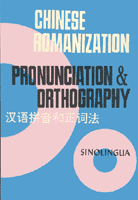 The latest excerpt from Yin Binyong’s book on Pinyin orthography covers how to write four-syllable idioms in Hanyu Pinyin (929 KB PDF). Here’s a key passage:
The latest excerpt from Yin Binyong’s book on Pinyin orthography covers how to write four-syllable idioms in Hanyu Pinyin (929 KB PDF). Here’s a key passage:
almost all four-character idioms can be broken in two halves, called yǔjié 语节 (language segments), on the basis of phonetic structure. The simple expedient of connecting the two yǔjié with a hyphen then provides idioms with their own distinctive written form, and assures ease of writing and reading. It is also a simple rule for students of HP to master.
But not all four-syllable idioms follow this rule, as the reading shows.
This is a worthwhile reading for Mandarin learners, even if you’re not particularly interested in Pinyin. There are many examples of idioms here, all given in Hanzi, Pinyin, and English.

Seems like a very ad-hoc solution, especially given the fuzzy line between chengyu and other four-character phrases. Proper word and phrase level spacing should be a higher priority. Selective hyphen insertion just introduces something new for people to get wrong.
Did you go through the full reading yet? It opens with a discussion of various approaches and acknowledges that this can be a tricky area.
On the other hand, the ABC Comprehensive Chinese-English Dictionary tends to render such things solid rather than hyphenated (or even separate). For example, ABC2 gives:
* jīmáosuànpí instead of Yin Binyong’s jīmáo suànpí (雞毛蒜皮)
* guīxīnsìjiàn instead of YBY’s guīxīn-sìjiàn (歸心似箭)
* guǐguǐsuìsuì instead of YBY’s guǐguǐ-suìsuì (鬼鬼祟祟)
* qīngqingchǔchǔ instead of YBY’s qīngqing-chǔchǔ (清清楚楚)
I need to see what YBY wrote about this in his later book.